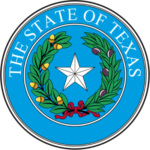Texas
Texas is a state located in the south-central region of the United States. It is bordered to the west by Mexico and New Mexico; to the north by New Mexico, Oklahoma, and Arkansas; to the east by Oklahoma, Arkansas, and Louisiana; to the south by Mexico, and the Gulf of Mexico.
- ABBREVIATION: TX
- NICKNAME: The Lone Star State
- POPULATION: 26,448,193 (2013 est.)
- CAPITAL: Austin
- STATE BIRD: Mockingbird
- STATE FLOWER: Bluebonnet
- AREA: 52,419 sq. mi.
- TIME ZONE: Most of state: Central, – tip of West Texas: Mountain
- ENTERED UNION: Dec. 29, 1845
- ALTITUDE: High, 8,751 ft. Guadalupe Peak
- CLIMATE: Varies widely. Coastal areas and eastern interior humid, with mild winters, hot summers. West very dry, with greater temperature range.


Here “big” is an adjective that never grows stale. Texas could accommodate all six states of New England-plus New York, Pennsylvania, Ohio, and Illinois. No single characterization can apply equally to the moss-hung oak forests on its eastern borders, the bays and lagoons of the Gulf Coast, the black prairie soil extending from San Antonio to the Red River valley, the sandy lowlands of the Rio Grande, the rolling plains in the interior, and the sharp canyons of the Pecos River valley. Moreover, almost any one of Texas’ major industries would in itself be sufficient to make a smaller state wealthy.
On the semi-arid high plains around Lubbock, artesian wells help make it possible for Texas to grow over six million bales of cotton each year, more than any other state. When it comes to oil production, Texas dominates over the other states; as of 2011, the state’s 27 oil refineries produce 4,754,681 barrels of oil per day, with reserves totaling 7,014 million barrels. The pecan is the state tree, and Texas orchards produce the third largest pecan crop in the country. The northern panhandle is a major source of the world’s helium; The Federal Helium Reserve in Amarillo provides 42% of the country’s helium and 35% of the world’s supply. No doubt, it’s a big state, name something, and Texas probably has it; unexploited coal, hurricanes, drought, floods, natural gas, sheep, citrus crops and so much more.

It was on the coastal plains south of San Antonio that the pioneers of the early 1800s founded the beef industry of the U.S. Later the yearly cattle drives along the Chisholm Trail towards Kansas became part of American lore. With an inventory of over 10 million cattle, Texas still remains the United States’ number one producer of beef.
FUN FACTS:
- Texas is bigger than the combined area of all seven countries in Central America. It is also bigger than every country in Europe except Russia.
- In 1900 a storm surge caused by a hurricane killed over 6000 people in Galveston. (Estimates range anywhere from 6000-12,000 dead)
- Six national flags have flown over Texas during the course of its history: Spanish, French, Mexican, Texan, Confederate, and American.
- Texas is noted for having towns with strange names, such as Goodnight, Cut and Shoot, Wink, Muleshoe, North Zulch, Birthright, Turkey, and Noodle. A city named Iraan is made up of the first names of Ira and Ann Yates who struck oil on their farm in 1926.
- Both the silicon computer chip and the electronic calculator were invented by engineers at a company named Texas Instruments.
- Most states entered the United States by way of territorial annexation, but Texas is the only state to enter by treaty.
